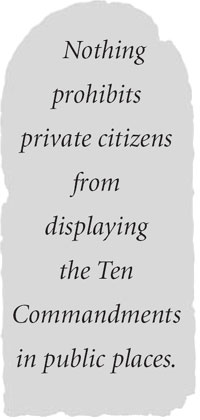Showing Proper Respect
J. Brent Walker May/June 2005
Getting your Trinity Audio player ready...
The United States Supreme Court will consider two cases challenging Ten Commandments displays under the First Amendment's establishment clause this term. One case, Van Orden v. Perry (03-1500), involves a Ten Commandments monolith donated in 1961 by the Fraternal Order of Eagles, and displayed with the authorization of the Texas legislature on the grounds of the Texas capitol. The constitutionality of this display was upheld by the Fifth U.S. Circuit Court of Appeals. The court ruled that the monument has a secular purpose of teaching about our legal system, and denied that any reasonable observer would view it as an endorsement of religion. The second case, McCreary County v. ACLU (03-1693), involves displays in courthouses in two Kentucky counties. There the Sixth Circuit ruled that these displays do not have a sufficiently secular purpose and have the primary effect of endorsing religion. These cases are expected to be decided before the end of the Court term in June 2005.
Media tend to present the dispute as a clash between forces of secularism trying to ban religion from the public square and people of faith bent on promoting morality through the offices of government. This dichotomy is unfortunate and misleading. Many people of faith and religious organizations oppose government endorsements of the Ten Commandments for reasons having everything to do with religion and religious liberty.* Everyone's religious liberty is denied when government officials select the preferred religion, pick out a particular passage of sacred text, and display it in a way that carries with it the full endorsement of the state.
Opposition to government-sponsored displays of the Ten Commandments is buttressed by several rationales. Such displays are often unconstitutional, based on bad theology, predicated on a misreading of history, and contrary to notions of fundamental fairness.

The Ten Commandments displays in Kentucky, though less dramatic in size and presented on the walls of courthouses, amount no less to an endorsement of religion. After the litigation began, Kentucky officials added some secular documents, but the message endorsing the Decalogue remained clear.
The unconstitutionality of these endorsements of sacred texts is supported by Supreme Court precedent. In Stone v. Graham, 449 U.S. 39 (1980), the Court ruled that the posting of the Ten Commandments by the state of Kentucky in public school classrooms violated the establishment clause. The Court reasoned:

There are also important theological reasons that many people of faith object to government posting and endorsing of holy writ. It puts government officials in the role of priests, making fundamentally theological determinations that they are ill-suited to make. How can they speak to questions such as: The commandments of Deuteronomy 5 or Exodus 20? Is it an English Old Testament version, or the Hebrew Bible, or maybe the Septuagint in Greek? If in English, is it a Catholic or Protestant one? If Protestant, which version-King James, New International, Revised Standard? All of these vary in language and theological import. For example, the Hebrew Bible is translated "murder," while the various English versions render the word "kill." The Catholic version says nothing about "graven images," but has two commandments on "coveting." There are many "Ten Commandments," not just one, and government officials are not competent to pick and choose from among them. These decisions are best left to families, churches, and synagogues.
Moreover, one cannot properly interpret a sacred text without considering the context. The Ten Commandments, including the first one-"I am the Lord your God. . . You shall have no other gods before me" (Exodus 20:2, 3)